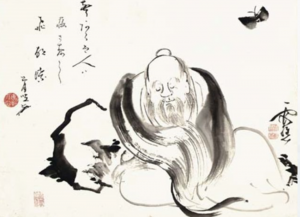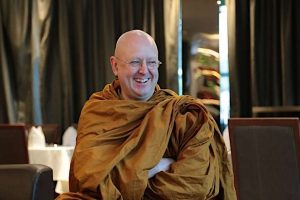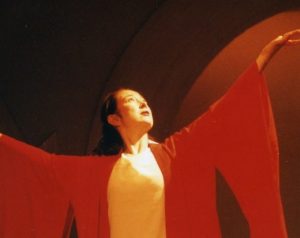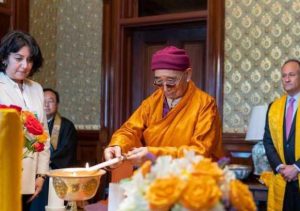There is more than one path into the future, but mostly we travel a well-known road we think will lead us to the destination where we imagine we should be. No wonder we are stunned and filled with regret when we discover that our journey has taken us to some place dark and fearsome.
This archetype is the basis for many a hero’s quest, where we leave home, encounter demons, vanquish them and emerge from the wood into a shining new day. We are therefore doubly confused when we discover that even this telling is fraught with missing puzzle pieces, indecipherable codes, misdirection, and hollow truths.
In this state of not knowing, a kind of bardo, we may be open to another way of seeing, another path that some fellow traveler reveals as a shortcut down the mountain. Shinko Roshi is one such kindred spirit. Sitting by the fire on a moonless night, she has a tale to tell.
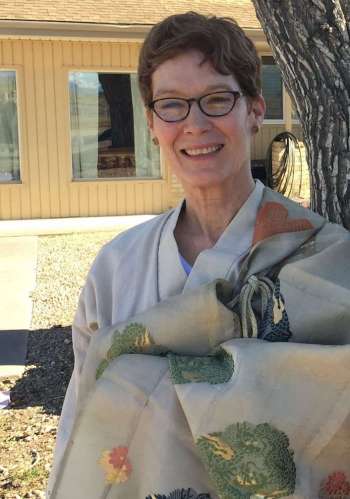
Simply put, Shinko Roshi grew up as Ilia Perez, a little girl in a devout Catholic family in Puerto Rico. Sometime in her childhood, she had a vision of a Woman of Light and this became the basis for a lifelong journey of discovery. Her journey led her to Zen and years of arduous practice under a variety of teachers. She achieved deep wisdom and high honors. Alas, it was unfulfilling and in many ways stifling as she encountered the patriarchal blinders she was asked to put on as a woman. Again and again, her vision was discounted as ignorant and pernicious, but that did not ring true for her. Eventually, she found her way to Vajrayana practice and the invocation of the Five Goddesses. And things changed.
We postmodern Buddhists like to say that feminization is one of the great evolutions of the Dharma coming to the West, along with laicization and democratization. But what if those ideas were there all along and we just missed them? The original sangha was indeed a rejection of priestly power and a refocusing on egalitarian relationships. But if we go even further back in time, like archeo-cosmologists, we may discover that the Great Goddess was always there, always caring for us, only later to be forced underground.
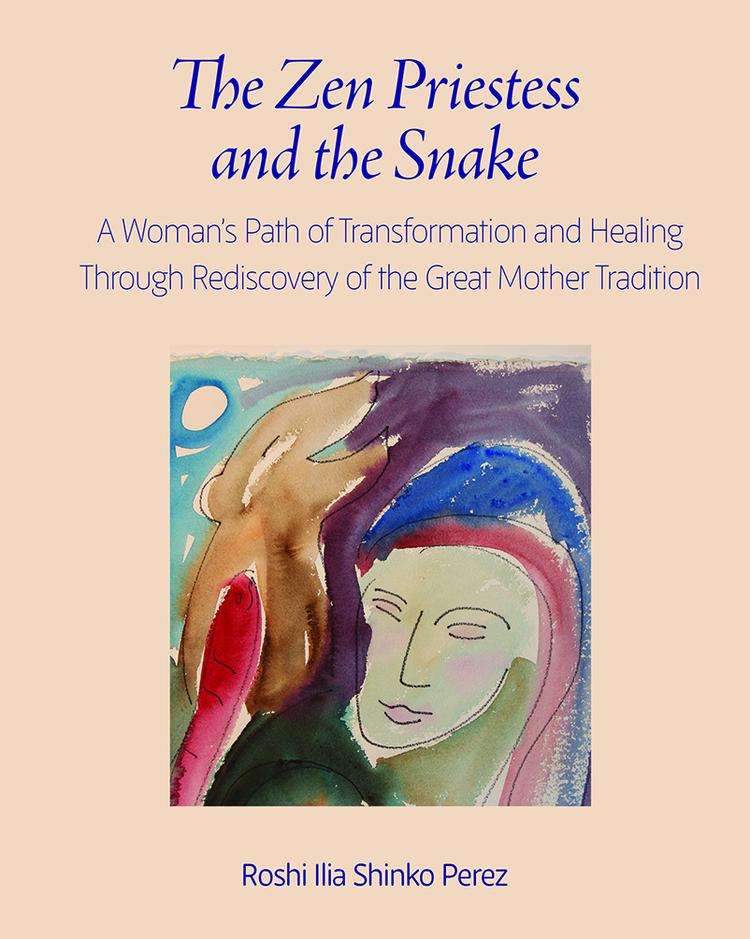
And so Shinko Roshi began to embrace what she calls the Great Heart Way, honoring the feminine and expanding her practice in new inclusive ways. A bigger Zen, if you will.
But it didn’t stop there. This is not some solitary journey by a hero or heroine. It is a clarion call for all of us to return to Mother Earth in a new relationship founded on sustainability. And that is where it really gets interesting!
In her most recent book, The Zen Priestess and the Snake: A Woman’s Path of Transformation and Healing Through Rediscovery of the Great Mother Tradition (Sumeru Press 2020), Shinko Roshi describes her journey as prologue, and presents a Zen practice manual infused with Bön Buddhist techniques—the Five Goddess Practices. It’s not just a story; it’s an invitation.
Buddhistdoor Global recently corresponded with Shinko Roshi about her book and her approach to Buddhism. Here are just a few of the highlights we touched upon . . .
Buddhistdoor Global: Some may accuse you of syncretism in your melding of Zen and the Bön Buddhist tantric practice of invoking the Five Goddesses. How do you respond to them?
Shinko Roshi: The origin of the Five Goddess Practices is more ancient than Bön itself. The practices were discovered by the Bön tradition in the eighth century but the practices predate that by many centuries. They were transmitted orally. When the religion of the Great Mother was persecuted in Old Europe and the Middle East, her religion entered the Indus Valley during the Neolithic era. Scholars believe that the root of tantra came from the very early Indus Valley traditions. These same traditions are also linked to Neolithic Europe. Both cultures were matrifocal and they saw the supreme energy as feminine. I am only bringing awareness to the feminine roots of Zen that already existed. The Goddess Practice that I teach is no other than the manifestation of Prajnaparamita, the embodiment of wisdom and emptiness in female form, which is known as the Mother of All the Buddhas.
One of the things that I love about Zen is that is flexible and always absorbs the culture of the country where it lands. Now that we women are waking up and recovering our severed roots, it is wonderful to have a tradition like Zen that can make room for us and incorporate our ancient traditions. We have been pushed away from who we are for a long time, but now at a time when patriarchy has almost destroyed the Earth, the rising of the Sacred Feminine brings hope for the planet. Just to quote the Dalai Lama’s words: “The World will be saved by the Western Women.”
On the same note, Zen Teacher Norman Fischer merged Zen with Tibetan Buddhism in his book, Training in Compassion: Zen Teachings on the Practice of Lojong (Shambhala Publications 2013). And Vipassana Teacher Joseph Goldstein explores the similarities of Zen, Tibetan Buddhism and Theravadin Buddhism in his book, One Dharma: The Emerging Western Buddhism (HarperOne 2003). In the West, we are open to a range of upayas that might not be strictly Zen. In fact, Western psychology is making great inroads into Zen and other Buddhist teachings.
BDG: In your book, you allude to this practice as a journey of healing. What is being healed?
SR: My roots were healed. I felt lost before starting my Zen journey, like a tree without roots and without leaves. Lost in the world and shut in silence. Now I know where I come from, who I am, to whom I belong to by choice and what I should be doing on this planet at this time. This kind of knowing is clarity. I have recovered my voice, which is the voice of my ancestral women—all of the women who were killed for honoring the Sacred Feminine; and also the old tea ladies who sold tea and cakes adjacent to famous monasteries they were not allowed to enter. They had to do this in order to support themselves in order to get a few crumbs of the Dharma. They were enlightened women. I carry them in my heart, and they share my name, Shinko, which means body of light.
BDG: You describe reciprocity between personal healing and healing of the planet. How does that work?
SR: I honor my emotions and my feelings. When I teach about the Sacred Feminine, I feel the shame that has been put on Her. After all, our patriarchal civilization that is currently destroying our planet was rooted in the persecution, denial, and suppression of the Sacred Feminine and of women’s power in general. In the Garden of Eden, the snake, originally a symbol of the wisdom of the Great Mother Tradition, was portrayed as a symbol of evil; Eve is accused of causing the fall of humanity; the powers of creation of women are taken away when we are told that Yahweh makes Eve from the rib of Adam and commands women to be subservient to men. Even in modern history, from the 15th–18th centuries, eight million women were accused of being witches and were hanged or burned alive. These were simple countrywomen who had learned the ways of the Goddess from their mothers or grandmothers. Can you imagine? Eight million of our women ancestors who carry the knowledge of the Sacred Feminine were killed! I am using these examples to show how deep the shame is that has been put on the Sacred Feminine. When I teach about the Sacred Feminine, I feel the personal and the collective shame that has been put on Her. Just by thoroughly feeling this shame with presence and without adding stories of “poor me” to these feelings, they are able to release on their own. Then I feel more connected with my role in speaking out about the real history of women.
BDG: How do you see that dynamic playing out over the next 10 years?
SR: In the next 10 years, I see more men reclaiming the feminine in themselves and embracing those ways of vision and intuitive knowing. Maybe this transformation will help gender fluidity to become mainstream in the future as we work together to save the planet.
BDG: How is living through the pandemic changing your heart and mind?
SR: The pandemic has allowed me to be in retreat for almost a year now and it has helped me to raise the mind of unconditional gratitude. This unconditional gratitude is a state of mind that connects me with all sentient beings, our planet, and the cosmos.
I would love to see that in the next 10 years this country [the United States] is unified by our common effort to save the planet and all the creatures that otherwise will become extinct.





